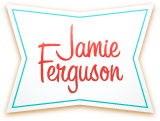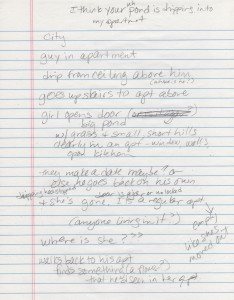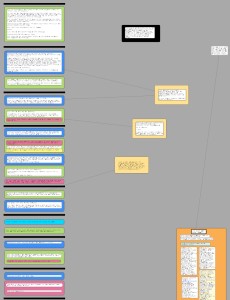The best laid plans
The urban fantasy novel I’m working on started as a short story (ha) I wrote for a writing workshop taught by Dean Wesley Smith. The assignment was to write an urban fantasy story having something to do with “many worlds.” I was stumped. I kept thinking: urban fantasy means vampires, werewolves, zombies … creatures I’m not opposed to (as long as I don’t meet any personally), but I’ve never written about them, nor had writing that type of story ever even occurred to me. My mind was a blank. One day I talked with three of my friends about the assignment and how I had no clue what to do. By the end of our conversation I had written this.
That might not look like much to anyone else, but I was super excited. Not only did I finally have an idea for my homework assignment, I knew this story would be really fun to write – and it has been!
I tend to scribble notes like this when I start a new story. This example is pretty straightforward and, to me at least, describes most of chapter one. I added a few things – like the guy doesn’t find a flower, he finds the girl’s pet frog, Douglas. But still, this was a great outline for the opening of the book.
Sometimes my notes are a little rougher. Take a look at this one for my selkie novel. I scribbled it on the back of a boarding pass.
This one is a little more cryptic – even I had to take a minute to figure out what it represents. I have no idea what “TPM” stood for, although I’d have to guess one of the four viewpoint characters since I recognize the code names for the other three (M, K, and MCù). (When I drew this I hadn’t named the fourth character yet, so TPM presumably stood for something meaningful.) Obviously this is not as detailed as the first image – or is it? To me, there’s actually a ton of information in this drawing. It’s just in a form of graphical shorthand that makes no sense to anyone who doesn’t know the story – which is pretty much everyone except me at this point.
Notes and diagrams like this help me a lot, but once I get going I need something a bit heftier. I’ve been experimenting with Scapple, which is a mind-mapping-like tool made by the folks who make the writing application Scrivener. (For the record, I still use Word to write, but everyone I know who uses Scrivener loves it.) I’ll write a more detailed post at some point – for now, here’s a snapshot so you can get a feel for how I’m using Scapple for outlining. I’m experimenting with using different colored shapes to indicate which character is the viewpoint character.
The left side is the outline; each box represents a single scene, and the black bars indicate chapter breaks. Notes about the setting or characters are scattered off on the right side. This is still very much an experiment, but so far it has been helpful.
I’m a much more efficient writer when I have a plan ahead of time, so I’ve been trying to improve my outlining process. I don’t do much (if any) outlining for short stories. I might have a scribbled picture like the one above, but because of the length I don’t need a detailed outline like I do for longer works. I tend to write sparse outlines for novels, with big gaps where I haven’t figured out what happens yet. That’s worked okay up until now, but when I have to fill in those gaps I tend to spend a lot of time thinking and/or researching, which is fun but not very efficient.
I do like having outlines more on the sparse side, probably because often a story will change while I’m writing it. But I find it significantly less disruptive to have a plan change than to reach a spot in a story where I have no clue what happens next.
Here’s a photo of my writing assistants from this morning. They always have a plan … there’s a pine cone on the ground in front of Jasper, and they’re both waiting for me to throw it. Note that they’re also blocking the trail…





I’m going to follow this great advice! As someone who writes without an outline, I think I could benefit greatly from even some rough notes.
I admire your hard-working assistants, too. They look like they’re a huge help to you 🙂
They are very helpful … they make sure I get up and play ball every once in a while so I don’t spend too much time at the computer. 🙂
I’ll post more on outlining once I see how the new approach I’m trying goes. My process has worked okay so far, but I’m hoping I can improve it in a way that makes a real difference. I’ll report back!